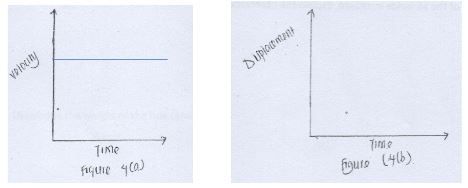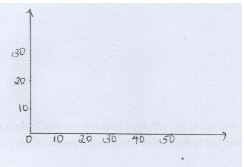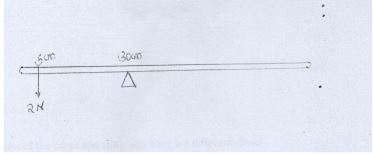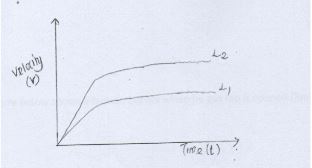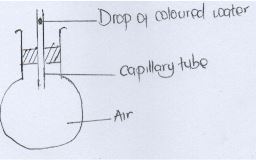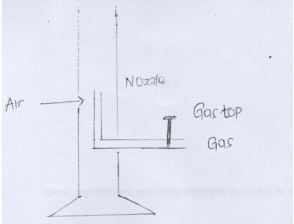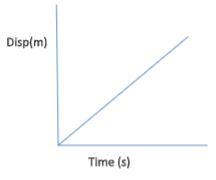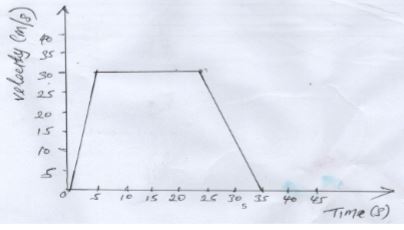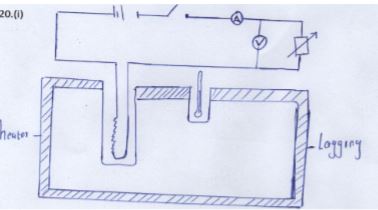PHYSICS
PAPER 1
Instructions to the candidate
- Write your name and the admission number in the spaces provide above
- Answer all questions

Questions
SECTION 1
- Figure (a) below shows a velocity-time graph of motion an object
Sketch on the axis the provided In figure (b) the displacement-time graph of the motion (2mks) - A car starts from rest accelerates uniformly for 5seconds to reach 30m/s. It continues at this speed for the next 20 seconds and then decelerates uniformly to come to stop in 10 seconds. On the axis provided, draw the graph of the velocity against time for the motion of the car (.4mk)
- Water in a tin-can was boiled for some time. The tin-can was then sealed and cooled. After some time it collapsed. Explain this observation.2mks
- When a bicycle pump was sealed at the nozzle and the handle slowly pushed towards the nozzle the pressure of the air inside increased. Explain the observation. 2mks
- An immersion heater rated 90W is immersed in a liquid of mass 2kg.When the heater is switched-on for 15 minutes the temperature of the liquid rises from 20oc to 30oc. Determine the specific heat capacity of the liquid (assume no heat loses). 3mks
- The figure below show a uniform meter rule pivoted at 30cm mark. It is balanced by weight of 2N suspended at the 5cm mark.
Determine the weight of the rule (2mks) - Small quantities of hydrogen and helium at the same temperature are released simultaneously at one end of a laboratory. State with reason which gas is more likely to be detected earlier on the other end. 2mks
- Two identical spherical steel balls are released from the top of two tall jars containing liquid L1 and L2 respectively. The figure below shows the velocity-time graph of the motion of the balls.
Explain the nature of the curve and state why they are different. 3mks - The figure below shows a round bottom flask fitted with a long capillary tube containing a drop of coloured water.
The flask is immersed in ice for some time. State the observation made (2mks) - The figure below shows a Bunsen burner when he gas tap is opened .
Explain how air is drawn into the burner when the gas tap is opened.( 3mks) - A bag of sugar is found to have same weight on the planet earth as an identical bag of a dry saw dust on the planet Jupiter. Explain why the masses of the two bags must be different. 2mks
SECTION 2
-
- A hole of area 2.0cm2 at the bottom of the tank 2.0M deep is closed with a cork. Determine the force of the cork when the tank is filled with water.(density of water is 1000kg/m3 and acceleration due to gravity is 10m/s2) 4mks
- The total weight of car with passengers is 25,000N.The area of contact of each of the four tyres is 0.025m2 . Determine the minimum pressure (3mks)
- A cyclist initially at rest moved down a hill without peddling .He applied brakes and continually stopped. State the energy changes as he cyclist moved down a hill. (1mk)
- The figure below shows a mass of 30kgs being pulled from the point P with force of 200N Parallel to an inclined plane .The distance between P and Q is 22.5 M . In being moved from P to Q it is raised through a vertical height of 7.5 M
Determine the work done- by force (2Mks)
- On the mass (2mks)
- To overcome friction (1mk)
- Determine the efficiency of the inclined plane .(2MKS)
- A cart of mass 30kgs is pushed along a horizontal path by a horizontal force 8N and moves with constant velocity. The force is then increased to 14N. Determine the;
- The resistance to the motion of the cart. 2mks
- The acceleration of the cart. 2mks
- A horizontal force of 2N is applied on a wooden block mass of 2Kgs placed on horizontal surface .It causes the block to accelerate to 5ms-2. .Determine the frictional force between the block and the surface. (3mks)
- A ball is thrown horizontally from the top of vertical tower and strike the ground at A point 50 m from bottom of the tower. Given that the height OF the tower is 45m determine
- The time taken by the ball to hit the ground. 3mks
- the initial horizontal velocity of the ball. 3mks
- Vertical velocity of the ball just before striking the ground (take acceleration due to gravity, g, as 10ms-2. (3MKS)
-
- A long horizontal capillary tube of uniform, bore sealed at one end containS dry air trapped by a drop of mercury. The length of the air column is 142mm at 17oc. Determine the length of air column at 25oC. (3mks)
- The pressure of air inside a car tyre increases if the car stands out in the sun for some time on a hot day. Explain the pressure increase in terms of the kinetic theory of the gas (3mks)
- An immersion heater rated 2.5KW is immersed into a plastic jug containing 2kg of water and switched on for 4 minute . Determine.
- The quantity of heat gained by water 3mks
- The temperature change of water. (3mks)
(Take specific heat capacity of water as 4.2x 103 Jkg-1xk-1
-
- The figure bellow shows an incomplete set up that can be used in an experiment to determine specific heat capacity of a solid of mass M and temperature Ө1 by electrical method.
- Complete the diagram by inserting the missing component of the experiment. 2mks
- Other than temperature state three measurements that should be taken (3mks)
- The final temperature was recorded Ө2, write an expression that can be used to determine the specific heat capacity of the solid. 2mks
- State three ways of increasing he sensitivity of liquid –in-glass thermometer. 3mks
- The figure bellow shows an incomplete set up that can be used in an experiment to determine specific heat capacity of a solid of mass M and temperature Ө1 by electrical method.

Marking Scheme
-
-
- When a can is heated, air molecules are expelled from the can. When sealed the steam pressure balances the atmospheric pressure. On cooling the steam condenses creating partial vacuum on the inside . The outer atmospheric pressure on the outside makes the can Collapse.
- The volume decreases so the collisions of the molecules with wall of the container increased hence the pressure increases
- Assuming no heat loss , heat gained by the liquid =pt
MC?Ө=Pt
2C x(30-20)=90x15x60
C=PtMΔӨ = 90x15x602(10)=4050J/Kg 2a - 2x0.25=0.2xW
W=2x0.250.2=2.5N - Hydrogen diffuses faster than helium since it is less dense
- Initially the two balls accelerate through the liquid because of the weight, Mg greater than the sum of the upthrust and vicious drag. Viscous drag however increases with increase in velocity. The difference In the two graph is the fact that viscocity of L1 is greater than the viscocity of L2
- The drop of coloured water initially rises up slightly then starts to drop
- When the gas top is opened, gas flows at high speed creating a low pressure region above the nozzle . The higher the pressure on the outside pushes in air and the gas burns.
- The gravitational force is different on different planets. Since the weight of the two bags is the same, then the masses must be differen
-
- Force=pressure x Area
P=ɦℓG=20x100x 10=20000 N/m2
F=20000x210000=4N
OR
MASS= density x volume
=1000=1000x210000 x 2=0.4kg
Force= mass x gravity= 0.4kg x10= 4N - P=FA=25000.25x4=25000pa
- potential energy kinetic energy heat+ sound
- Force=pressure x Area
-
- Work done by forcer = F d=200x22.5= 4500J
- Work done by mass =M g h=30x10x7.7=2250J
- Work done to friction=work done by force -work done on mass =4500-2250J
- efficiency=x=work output work input x 100=22504500 x 100=50%
-
- Resistance=8N
- F=ma 14-8=30a a=6/30=o.2m/s2
16 F=MA =2x5=10N - Frictional force =applied force-accelerating force = 12N-10N=2N
-
- since U=0,S=1/2g2 →45=1/2 x10 x t2→ t=3s
- S = u t, 50=U x 3 →u=16.7 m/s
- V=u + g t=0+10x3==30m/s
-
- V1 =142mm, T1=278+17=17=290 v2=? T2=298
v1v2= v2T2= 142290= v2298 → V2=298x142290 = 145.92MM - The hot temperatures heat up he air inside the tyre and the molecules gain more kinetic energy and move faster since the volume is constant, the molecules collide more quickly with the walls of the tyre which leads to the greater change of momentum per unit time. This leads to greater change per momentum per unit. This leads to an increase in pressure
- V1 =142mm, T1=278+17=17=290 v2=? T2=298
-
- Heat = power x Time =2500x 4 x60 = 600,000 Joules
- 600,000 MC?Ө=2x 4200 x?Ө ΔӨ=6000002x 4200=71.43OC
-
-
- voltage from the voltammeter. Curre Nnt from ammeter .Time from stopwatch
- VIt = MC (Ө2-Ө1) , c =VIT M(Ө2-Ө1 )
- Reducing the size of the bore
-
- Making the bulb thin
- Reducing the size of the bulb
-
Download Physics Paper 1 Questions and Answers - Form 4 Opener Term 1 Exams 2022.
Tap Here to Download for 50/-
Get on WhatsApp for 50/-
Why download?
- ✔ To read offline at any time.
- ✔ To Print at your convenience
- ✔ Share Easily with Friends / Students

